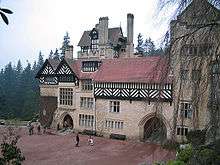Cragside
| Cragside | |
|---|---|
|
| |
| General information | |
| Type | Country house |
| Location | Rothbury, Northumberland |
| Country | England |
| Coordinates | 55°18′49″N 1°53′08″W / 55.31361°N 1.88556°WCoordinates: 55°18′49″N 1°53′08″W / 55.31361°N 1.88556°W (grid reference NU0702) |
| Completed | 1863 |
| Renovated | 2007 |
| Owner | National Trust |
| Grounds | 400 hectares (1.54 sq mi) |
| Design and construction | |
| Architect | Richard Norman Shaw |
| Designations | Grade I listed |
| Website | |
|
www | |
Cragside is a country house in the civil parish of Cartington, near Rothbury in Northumberland, England. It was the first house in the world to be lit using hydroelectric power. Built into a rocky hillside above a forest garden of just under 1,000 acres, it was the country home of armaments manufacturer, Lord Armstrong,[1] and has been in the care of the National Trust since 1977. The property was eventually opened to the public in 1979.
Cragside, named after Cragend Hill above the house, was built in 1863 as a modest two-storey country lodge, but was subsequently extended to designs by Richard Norman Shaw, transforming it into an elaborate mansion in the Free Tudor style. At one point, the building included an astronomical observatory and a scientific laboratory. The Grade I listed[2] house is surrounded by one of Europe's largest rock gardens, a large number of rhododendrons and a large collection of mostly coniferous trees. One variety of rhododendron is named after Lady Armstrong.[3]
In 2007, Cragside reopened after undergoing "total refurbishment."[4]
History

Lord Armstrong spent much of his time as a child in Rothbury to get away from industrial Newcastle to alleviate his ill health.[5] He returned to Rothbury after not having a holiday for many years and decided to build a modest house on the side of a moorland crag. The original house was completed in 1863 by an unknown architect but was transformed by architect Richard Norman Shaw between 1869 and 1884 into an imposing mansion. Cragside is an example of his English Gothic style. The interiors are of national importance for its collection of furnishings, furniture (much designed especially for Cragside), and fine and decorative arts, including work by many other outstanding designers of the age, such as John Hancock and Albany Hancock and William Morris.[6]
Electricity

In 1868, a hydraulic engine was installed, with water being used to power labour-saving machines such as laundry equipment, a rotisserie and a hydraulic lift. In 1870, water from one of the estate's lakes was used to drive a Siemens dynamo in what was the world's first hydroelectric power station. The resultant electricity was used to power an arc lamp installed in the Gallery in 1878. The arc lamp was replaced in 1880 by Joseph Swan's incandescent lamps in what Swan considered 'the first proper installation' of electric lighting.
The generators, which also provided power for the farm buildings on the estate, were constantly extended and improved to match the increasing electrical demand in the house. The 2006 regeneration project included extensive rewiring.[7]
A new hydro-powered electricity generator was installed in 2014; it can provide 12 kW representing around 10% of the property's electricity consumption. The new system uses an Archimedes' screw 17 metres (56 ft) long .[8]
The use of electricity in many of the houses gadgets and internal systems has also led it to be described by some as a smart home as it was the first private residence to use incandescent lighting, a dish washer, a vacuum cleaner and a washing machine. One of Armstrong's stated aims of both using and funding these new automation technologies was to "emancipate the world from household drudgery", as shown on a plaque at Bamburgh Castle, his other residence.
In the media
The Open University Arts Foundation Course (A102) featured Cragside in one of its programmes in 1987.[9]
The documentary series Abroad Again in Britain by Jonathan Meades focused on Cragside in episode 2 (2005).
Cragside was featured during the 21 August 2011 episode of BBC One's Britain's Hidden Heritage programme,[10] and in the 2013 ITV series Inside the National Trust, presented by Michael Buerk[11] The house and garden was also featured in the BBC One series of Glorious Gardens from above on 18 November 2014.[12]
Gallery
 A view across one of the tarns on the Cragside Estate.
A view across one of the tarns on the Cragside Estate. Panoramic View from Gardens on Cragside Estate.
Panoramic View from Gardens on Cragside Estate. Cragside Tarn 360 Panorama.
Cragside Tarn 360 Panorama. Cragside Noth Lake Panorama.
Cragside Noth Lake Panorama. Cragside Nellys Moss 360 Panorama.
Cragside Nellys Moss 360 Panorama.
References
- ↑ Bernard Porter, "Cragside". History TodayVolume: 45 Issue: 1 1995. Accessed 26 August 2014
- ↑ Historic England. "Grade I (236348)". Images of England.
- ↑ "The best gardens to see rhododendrons", The Telegraph. Accessed 27 August 2014
- ↑ Vanessa Thorpe (2007-03-31). "Restored: the world's first hydroelectric house". London: guardian.co.uk. Retrieved 2010-07-17.
- ↑ "Cragside, History". The National Trust.
- ↑ "Cragside Rewiring 'A Temple to High Victorian Technology'". Building Conservation. Building Conservation. Retrieved 15 April 2015.
- ↑ "Rewiring 'A Temple to High Victorian Technology'" in The Building Conservation Directory, 2006. Accessed 26 August 2014
- ↑ Alex Kirby: "National Trust lights up historic mansion with hydropower" in The Guardian, 31 July 2014
- ↑ "Cragside", British Universities Film & Video Council, 1987. Accessed 16 April 2015
- ↑ "BBC One - Britain's Hidden Heritage, Cragside House". bbc.co.uk.
- ↑ "National Trust opens its doors for TV show", Telegraph, 4 Oct 2013. Accessed 26 August 2014
- ↑ "Glorious Gardens from above". BBC. Retrieved 13 July 2015.
External links
| Wikimedia Commons has media related to Cragside. |
